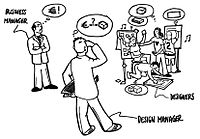
Photo from wikipedia
This article presents a case of how co-design approaches are used as a means to facilitate employees' learning and innovation. Despite a growing interest in co-design and the effects of… Click to show full abstract
This article presents a case of how co-design approaches are used as a means to facilitate employees' learning and innovation. Despite a growing interest in co-design and the effects of engaging citizens (or users) in public service innovation, far too little attention has been paid to the potential influence and learning dynamics of: 1) inclusion of user perspectives; 2) of using co-design approaches on employees' practice, learning, and innovation. Through the theoretical lens of 'boundary encounters', this article offers a learning perspective on the influence of co-design approaches on employee-driven innovation. It reports the findings from an exploratory case study in a prison context. The analysis shows that including user perspectives creates strange perspectives on familiar routines, and that reflective and transformative learning dynamics emerge in sequences of experience prototypes and storytelling. It is argued that co-design approaches hold potential for employees to reframe meaning and innovate practice, and can enhance individual and organisational learning.
Journal Title: International Journal of Entrepreneurship and Innovation Management
Year Published: 2018
Link to full text (if available)
Share on Social Media: Sign Up to like & get
recommendations!